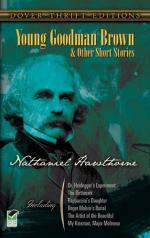|
This section contains 2,040 words (approx. 7 pages at 300 words per page) |

|
SOURCE: "Hawthorne's 'Young Goodman Brown': An Attack on Puritanic Calvinism," in American Literature, Vol. XXVIII, No. 3, November, 1956, pp. 370-75.
In the essay below, Connolly argues that Goodman Brown learns through his experiences that Calvinism is a faith which condemns its followers to eternal damnation.
It is surprising, in a way, to discover how few of the many critics who have discussed "Young Goodman Brown" agree on any aspect of the work except that it is an excellent short story. D. M. McKeithan [in "Hawthorne's Young Goodman Brown: An Interpretation," in Modern Language Notes LXVII, No. 94, February 1952] says that its theme is "sin and its blighting effects." Richard H. Fogle in ["Ambiguity and Clarity in Hawthorne's 'Young Goodman Brown,'" in New England Quarterly XVIII, December 1945] observes, "Hawthorne the artist refuses to limit himself to a single and doctrinaire conclusion, proceeding instead by indirection," implying, presumably, that it is...
|
This section contains 2,040 words (approx. 7 pages at 300 words per page) |

|


